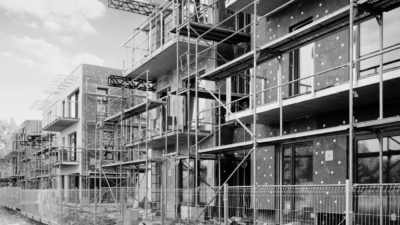They say that necessity is the mother of invention. Let’s hope this is true, as there are few commodities this country needs more than housing, and we are well overdue a completely fresh approach.
If we are to start making substantial change, we must begin by overhauling both our strategy and regulations.
Unfortunately, housing scarcity is a historical issue that continues to be left unaddressed.
We must be willing to admit when our planning system is broken and no longer catering to the demands placed on it, so that we can start to fix it.
An excellent example of this willingness to accept the new and operate from a place of innovation is evident in the creative minds that have been transforming offices into apartments across London.
It is well known that there is a dwindling demand for offices in the capital, with vacancies at a 30-year high.
Meta paid £149 million to break a 20-year lease before even moving into their new offices. With the enduring popularity of hybrid as a by-product of the pandemic, it’s high time businesses accepted that we won’t be returning to offices in the same way again.
This shift in demand presents a distinct opportunity in the residential sector – something that the City of London and developer HUB have recently capitalised on.
The former plans to use the Square Mile to create 1,500 new homes by 2030, while the latter recently paid £30 million for an office block close to the Barbican which will be transformed into low carbon flats.
Although offices are not the best starting point to produce new homes, it is possible – and the need for housing should inspire us to rise to the challenge.
Furthermore, we should be looking to the one million empty homes in England for solutions.
The shortage of accommodation can be addressed by revamping old homes for new housing, affordable or otherwise – but in order to make any timely progress, these projects must be supported by clear policies and planning processes.
Permitted Development Rights (PDR) have been introduced to speed up the construction of new homes by bypassing the need for planning permission in certain contexts, such as converting commercial buildings into residential.
However, a recently commissioned Government report has suggested this can lead to ‘worse quality’ homes and rising office rents.
This does not mean PDR should not continue to be used, rather they need to be re-thought with the wider community context in mind.
Considering and catering to the wider community while also addressing housing needs can be a difficult balancing act, particularly when it comes to conservation.
A recent report from a leading architect firm revealed that ‘much green belt land’ is not actually green – for example, only 59% of London’s Green Belt is agricultural land.
Within the greenbelt there are in fact former industrial sites that are having a negative impact on the environment.
If these sites were to be developed respectfully, their impact would be positive and ‘greener’ than the existing.
New builds present a significant opportunity to improve the environmental credentials of the UK’s housing stock.
Recent findings show that Britain has some of the oldest housing stock in Europe, making it incredibly energy inefficient.
Energy Performance Certificate (EPC) targets and regulations that rate the energy-efficiency of a home can encourage housebuilders to build better homes for Britons, but this must be done in partnership with developers so that the uncertainty of returns does not to deter investment.
Ultimately, it is partnerships – those between developers, homeowners, and the Government – that are the catalyst to in ensuring real change.
Although Help to Buy schemes have faced criticisms, such initiatives give first homebuyers more control and inspire developers into action.
The financial model of such schemes perhaps needs tweaking, as developers need to be sure that there will be demand for the homes they have built.
It is only through collaboration that we will all start to reap the benefits of reform – for developers to be supported by policies that make their projects financially and practically viable; for homebuyers to be choosing from a quality housing stock; and for the government to feel confident that development is being done at a sustainable rate.
If we start thinking laterally, fuelling creativity and innovation and encouraging adaptability, we can potentially look forward to a future of thriving residential development and diverse housing options.





















Comments